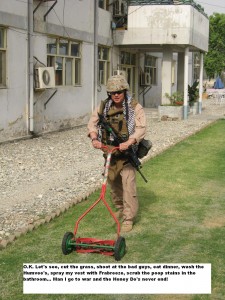History Lesson 101
June 1st, 2008 Posted in The SandGram v1.0This came from our XO, a fine young Air Force Officer who gave us a short brief on the Hazara. If you have read “Kite Runner” then you already have an idea of who the Hazara are and how they are treated. Here is a little background on them. This whole country is based off of tribes and clans, which makes putting them all together very difficult. We had a group of Police Recruits get into a fight last week because one group was Pashtu and the other Dari. They took to each other with metal pipes and caused some injuries but no deaths. See, there is the problem, they hate each other and it could be something that dates back to a bad business deal a century ago. Almost like the Hatfield and McCoys. Anyway, enjoy your first History lesson.
The Hazara are historically know as the descendants of Genghis Khan (GK). However, it is believed but not proven, that the Hazara were settled before GK invaded. The Hazara were not a “warrior” people so when GK invaded their land, although they resisted, they were easily defeated and it was then that the mix between the Mongol and the Hazara began.
They are primarily located in Central Afghanistan and their field of work has historically been “highland farmers.” They farm at over 10K feet above sea level. The Hazara are the third largest ethnic group in Afghanistan…only Pashtun and Tajik have larger groups. They are mortal enemies with the Pashtun. This stems from years of oppression forced upon them by the Pashtun. The Pashtun forced them to live as 2nd class citizens (only good for cleaning homes and baking bread).
In the 18th Century, the huge Pashtun push from the south forced many Hazara to the north and out of the Helmand and Kandahar regions. This is when they fled into the mountains of Central Afghanistan. The Pashtun continued the persecution of the Hazara and to this day, the largest settlement of Hazara can be found in the Quetta region in Pakistan (south west).
In the modern era, the struggles of the Hazara continue but with the coalition military influence, they are beginning to make head way into being seen as equals. Although the internal negative feelings of the Pashtun tribes exists, in order to make peace with the Allied forces, the Pashtuns must bury their feelings in public and symbolically accept the Hazara. The Hazara are utilizing this time of “being seen as equals” to put their children through school and also to get women involved in the work place and also the government. In one province, there is a female Governor…a Hazara woman.
The Taliban were also mentioned today and it was said that if the Taliban were allowed to continue their reign, the Hazara would be and extinct people.
Although it sounds as if the Hazara are utilizing this education for the good, popular belief is that there is still a bone deep resentment ingrained towards the Pashtun. The fluidity of this culture is amazing and seems like an incredibly tough up-hill struggle to refocus priorities of a people who’s history is nothing but war and misplacement.





